
|
<<Back |
Gran
Canaria, Spain
May 15-23,
2009 |
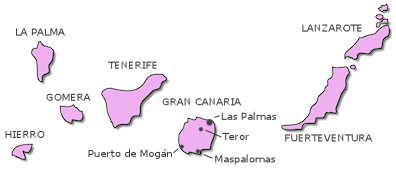
|
|
|
| A number of years ago, we impetuously
bought a timeshare week in Arizona. It has since become
somewhat of an albatross around our necks as the costs
associated with owning it have since increased while
the potential for exchanging our week at other resorts
has seemingly decreased. After an unsuccessful attempt
to score a week in Belize, we were faced with few options.
The Canary Islands seem to be a timeshare haven of sorts
in that there always seems to be some availability.
We always considered it a safety valve for future exchanges,
but the time was right to play that card. Tenerife had
the most availability but we were looking for something
more laid-back and opted for Gran Canaria instead. Our
vacation was in jeopardy from the get-go when the first
leg of our flight was delayed. The end result was a
spectacular face-plant by J in the Philly airport as
we ran to make the connection to Madrid. Despite bruised
arms and a bruised ego, we touched down in Gran Canaria
as scheduled. |
|
|
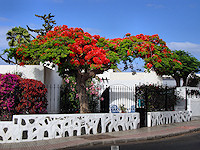
Canarian villa
|

The dunes of Maspalomas
|
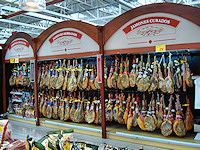
Spanish jamón ibérico for sale
|
|
|
We made our way by bus and
taxi to our resort in Maspalomas which is part of
the Costa Canaria along with Playa des Inglés
and San Augustin. These three towns have melded into
one another as the space between them filled with
hotels, restaurants, and shops. Maspalomas continues
to extend westward, and our hotel was in the fairly
new hillside region called Sonnenland. This had the
advantage of offering spectacular views of the Costa
Canaria but put us far from the beach.
The first thing one notices
about Maspalomas is that it is crawling with Brits.
The second thing one notices is that those people
who aren’t British are German. In fact, more Germans
visit the Canary Islands than any other nationality
but it feels like there is an overwhelming presence
of British. One thing you won’t see is Americans.
The Canaries are still a European stronghold, and
most people we spoke to back home had never heard
of the place. Spaniards, Scandinavians, and Dutch
make up the remaining tourist base.
The majority of the beaches
in the Canaries are composed of either volcanic black
sand or rounded rocks and pebbles. Some communities
have imported sand from the Sahara to create something
that is more in tune with the taste of the common
tourist. The Costa Canaria is blessed in this respect
in that a large portion of its coastal area is covered
with sand dunes. The dunes reach out to the Atlantic
providing enormous beaches that reach from Maspalomas
to Playa del Inglés. Although the dunes are
a protected area, there are three “trails” by which
they can be traversed. We spent a portion of one afternoon
trekking the dunes only to find they are a cruising
area for gay men as well as a popular nudist zone
– quite the combination.
Playa del Inglés is
actually a well-known vacation spot for homosexuals
– particularly males. The epicenter of gay nightlife
is the Yumbo, a typical Canarian shopping center full
of shops, restaurants, and clubs. We visited one evening
to have dinner and see what the fuss was about. We
ate an pleasant dinner at a Spanish-Italian fusion
restaurant at which we were one of 14 couples despite
J being the only female. Once darkness fell, the club
action began to pick up. Many featured live cabarets
with drag queens or bare-chested waiters. Several
of the more racier clubs advertised themselves as
cruising bars with men dressed as police or construction
workers. We paused awhile to have a coffee in a nearby
café to take it all in before returning to
our side of town.
|

The Yumbo during quieter times
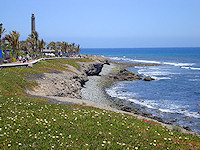
Faro de Maspalomas

One of the many Yumbo nightspots
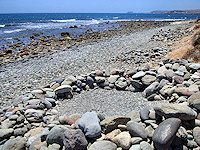
Sunbathing pits
|
|
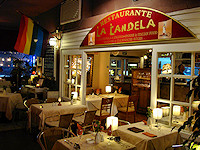
Fine dining at Playa del Inglés
|
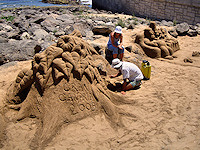
Master sand sculptors
|

A full English breakfast to
start the day
|
|
|

Caldera de Bandama
|
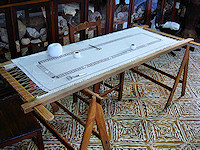
At the embroidery academy
|
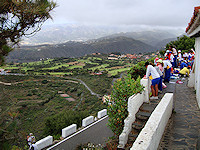
School children peer into the
caldera
|
|
|
The Canary Islands are an archipelago
in which each island is essentially a volcano arranged
in increasing age from west to east. While Gran Canaria
has had no volcanic activity for centuries, it still
retains the characteristic conical shape that one
might expect. This gives the island a diverse climate
in which the verdant northern and central parts of
the island receive significantly more rainfall and
are consequently more populated by residents who take
advantage of the fertile volcanic soil. The southern
side sees much less precipitation and much more sun,
making it the preferred location for tourist resorts.
We decided to see a little
more of the island than just the beach resorts, so
we booked a bus tour that would take us to visit some
of the inland villages and sights. We have never been
big fans of bus tours because it seems that we end
up driving for hours only to see something for ten
minutes. Still it does have its advantages such as
a driver who knows how to navigate the winding mountain
roads allowing one to sample the local cerveza
guilt-free. You also get to meet other tourists and
exchange tips on which restaurants to visit.
We drove for what seemed like
hours before arriving at Ingenio which was named for
the sugar cane processing plant that existed in Gran
Canaria’s rum-making heyday. When Spain finally obtained
control of the islands, they imposed their traditional
single-crop economic plan which began with sugar cane,
moved on to vineyards and wine, then cochineal for
red dye, and finally tomatoes. Today, of course, tourism
is the main source of income for the island, but their
rum trade heritage still manifests itself in a special
homemade blend of rum and honey called ron miel.
However, we were in Ingenio to visit the island’s
embroidery academy where we were let loose to buy
any tablecloth or doily that caught our fancy. Nothing
did. We were herded back on the bus to wind our way
up to the caldera at Bandama. Named for Daniel van
Damme, a Flemish merchant from the 16th century (Spain
ruled Flanders at the time) who bought and farmed
the area, the caldera measures over 3,000 ft in diameter.
The nearby peak offers stunning views of Las Palmas.
Our next stop was the very
charming town of Teror which has benefited greatly
from its reverence as a place of religious pilgrimage.
In 1481, an apparition of the Virgin Mary was seen
in a nearby pine tree, and the event has been celebrated
ever since. Teror has a magnificent 18th century church
at the end of a street lined by picturesque houses
with traditional Spanish wooden balconies. We lunched
in a restaurant overlooking a beautiful green valley
before moving on to see the Roque Nublo and El Fraile,
a basalt formation that is held sacred because it
resembles a friar kneeling in prayer. We stopped a
few more times for photo opportunities of the vistas
as we descended back down to Maspalomas in the evening
sun.
|
|
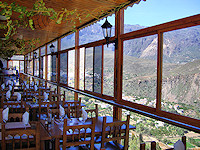
Lunch with a view
|

Teror town elders confer
|
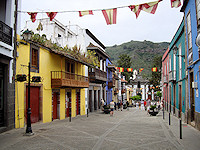
Main street in Teror
|
|
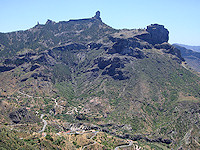
The Roque Nublo and El Fraile
|
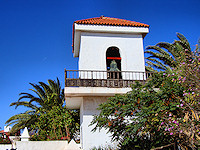
A campanario in Ingenio
|
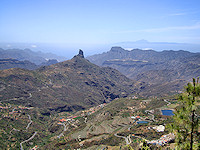
Tenerife looms in the distance
|
|
|

Puerto Rico
|
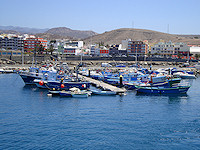
The fishing village of Arguineguin
|
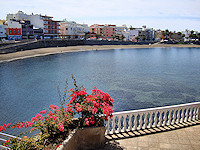
Arguineguin's beach
|
|
|
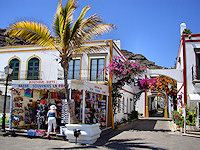
Puerto de Mogan

The bus back home
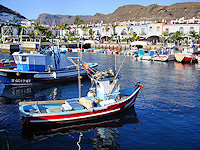
The marina at Puerto de Mogan
|
We had heard good things about
some of the ports further west along the coast, so
we decided to make a day of exploring them for ourselves.
We took an early bus to Arguineguín and strolled
around the fishing village to find a place to sit
and have a cup of coffee. The town itself is unremarkable
other than it offers some of the freshest fish in
the area and supply many of the resorts with their
catch of the day. Arguineguín has become somewhat
of a Scandinavian enclave, particularly for Norwegians
who have their own school, church, and newspaper.
We hopped a boat that took us a few miles further
down the coast to Puerto Rico, a huge resort town
carved into a valley between two cliffs. Its showpiece
is a large crescent-shaped beach of Sahara sand that
leads to a large shallow lagoon created by strategically
placed breakers. The area is a perfect example of
a modern Canarian resort town created out of nothing.
While Puerto Rico was a surprisingly
pleasant place to spend some time, we were put off
by the British hawkers wanting to push boat tours
and water sport activities to every passerby. So we
decided to move on since the best was yet to come.
Several people had urged us to visit Puerto de Mogán
claiming that it would be well worth our while. As
the boat chugged into the harbor, we were both struck
by how beautiful the port really was and why it was
referred to as “Little Venice” (not the first time
we had heard that moniker used). The buildings surrounding
the marina were all whitewashed in a Mediterranean
style with colorful trim and flowers that instantly
caused us to reach for our cameras. Once on shore,
we walked the narrow streets as vivid bougainvilleas
spilled over arches overhead. We learned later that
this part of the town had only been constructed 25
years ago as holiday apartments. Despite the lack
of authenticity, we knew this would be the end of
the line for us. We literally lounged for hours in
a restaurant that doubles as a lighthouse sipping
beverages and enjoying the view of the marina. Our
decision to stay in Puerto de Mogán and eat
dinner would cost us in the end because we knew that
instead of returning by boat to Maspalomas, we would
be subjected to a white-knuckle bus ride along the
steep cliff-top roads.
|
|
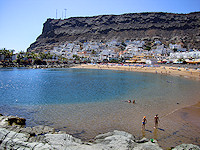
The beach at Puerto de Mogan
|
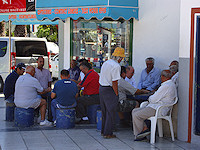
Afternoon dominoes
|
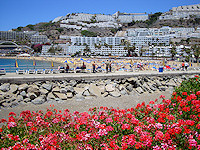
No shortage of hotels at Puerto
Rico
|
|
|
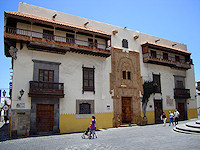
Casa Colón
|

Las Palmas
|
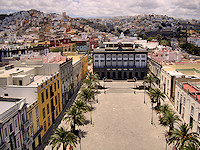
Plaza Santa Ana
|
|
|
Toward the end of our week
on Gran Canaria, we had both overdone the sunbathing
to the point where just sleeping at night was a painful
endeavor. So on our last day, we decided to see Las
Palmas, the capital of Gran Canaria and the Las Palmas
province. We jumped on the bus that stopped at every
little town, so we got the lengthy scenic tour between
Maspalomas and Las Palmas. Founded in 1478, Las Palmas
is most notable for being a stop on three of Christopher
Columbus’ transatlantic voyages. The house in which
he stayed while his ships were replenished is now
a museum dedicated to the explorer. Down the street
from the Casa Colón, in the oldest part of
Las Palmas known as La Vegueta, is the 16th century
Catedral de Santa Ana which is known as the Cathedral
of the Canaries. As the afternoon wore on, we both
felt a little melancholy as we realized that the following
morning we would be on our way back to the grind.
|
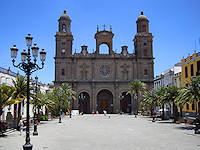
Cathedral of the Canaries
|
|

Gabinete Literario
|

The island's namesakes?
|
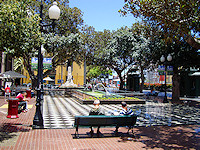
Relaxing in a Las Palmas plaza
|
|
Copyright © 2005 JnDsTravelog.com. All rights reserved. |
| |